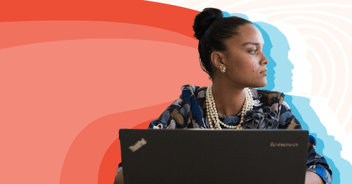
.png?width=960&name=Blog_workplace-marginalization_2%20(1).png)
The following is adapted from Love as a Business Strategy.
Have you ever been excluded? Were you ever not invited to a party when everyone else was? How did that feel?
Being excluded socially feels terrible, and it’s equally, if not more, demoralizing to be excluded professionally. A marginalized workforce is not only antithetical to a positive company culture, but also extremely damaging to business outcomes.
The tricky part is that organizations often aren’t even aware they are marginalizing their employees. Meanwhile, as this is happening, lasting damage gets inflicted within the company.
If marginalization might be occurring at your workplace, it’s time to take a careful look at how employees are included in both large and small ways. You’ll want to fix these problems before the damage to your employees’ morale, performance, and retention rates become devastating to your company’s long-term viability.
What is workplace marginalization?
Part of the reason marginalization goes unchecked is that many leaders don’t know how to recognize it when it happens. The truth is that marginalization can come in many forms. There are the obvious -isms—sexism, racism, classism, and ageism—but marginalization can happen to anyone for nearly any reason. Some marginalizations are small, and some are really big, extremely harmful ones.
Conversations around marginalization usually center around race. While race is important—and while it often is a key factor in issues of exclusion and marginalization—it is not the only way a person or a group of people can be marginalized. A person’s gender, religion, or ability could also be factors, as well as their job title, wealth, or social status.
Marginalization can happen in smaller ways, too, stemming from a difference like being left-handed. If you’re part of the 90 percent of the population that is right-handed, you may not think that being left-handed is that big of a deal. But then again, you’d have no reason to notice—the world is literally built for right-handed people like you.
Consider how a left-handed employee might feel if all of the scissors in the office are made for right-handed people. Nothing is designed for them. When they write, the text on the pen is upside down, the spine in the notebook gets in their way, and their hand smudges the ink as they move from left to right. Every day is a series of constant compromises and inconveniences.
As a leader, it’s up to you to notice these problems, big and small, and take steps to minimize them.
Dominant and Non-Dominant Groups
In order to have discussions around diversity, equity, and inclusion without focusing on any one criterion, it is important to understand the concept of dominant and non-dominant groups.
The basic premise of this concept is that, regardless of where you are or what room you enter, some people will have a lot in common in that room and some won’t. The former is the dominant group, while the latter is the non-dominant group.
These differences can be subtle, especially when there are obvious similarities among the members of the group. For instance, picture a room full of white men. All of them are married, have two kids, and root for the Packers—and all of them live in a similar type of neighborhood. However, their educational profiles are different; 80 percent of the men went to a private university, while the remaining 20 percent did not.
This difference may not sound as if it would matter that much, but it has the potential to become a constant, subtle undercurrent within many of the group’s conversations. For those 20 percent who didn’t attend a private university, they are constantly reminded of their otherness every time the dominant group starts sharing stories from their college days.
It’s not that the dominant group means to exclude the other people in the room. In fact, they’re probably not even aware that they’re doing it. Nevertheless, this unintentional behavior serves to exclude the non-dominant members—and if this dynamic is left unchecked, it could lead those members to feel like second-tier, or otherwise unequal, team members.
Create a Culture of Inclusion
Let’s say you’ve recognized marginalization within your organization—now what?
Creating inclusion is about more than just rooting out marginalization in all its forms. It’s about consciously making room for everyone at the table. It’s about how you welcome new team members into the group, how you make everyone feel inside of meetings, and how you handle conflict when it arises.
Understand and accept that differences do exist between you and your teammates. Not everyone grows up and experiences life in the same way across the board. To better understand and accept your teammates, make a conscious decision to practice patience. It’s not always easy to make room for others whose experiences you don’t fully understand. Conflicts, disagreements, and differences are inevitable—but that doesn’t mean they need to kill the conversation.
Furthermore, know that inclusion requires vulnerability. Pride, arrogance, and self-importance are antithetical to an accepting, supportive culture. It also requires advocacy. This is not a passive process. It’s not enough to give people of diverse backgrounds and experiences a seat at the table. You must also make sure they are heard as well.
Lead the Charge to Root out Marginalization
Whether we’re talking about not being invited to a party, being bullied for differences, or having to work with tools that don’t fit your hands, exclusion feels terrible. Your employees will not perform their best if marginalization is allowed to happen within your organization, so it’s up to you as a leader to drive the charge against it. Set a good example for the rest of your team.
By amplifying and validating the contributions of others who might not otherwise be heard, you not only reinforce the idea that they are welcome and valued, but you help your team develop and vet a broader range of ideas from which to consider and act. Everyone benefits.
While you can start the process of inclusion, know that you can’t do all the work alone. It is every team member’s job to elevate the voices of the unheard or the not-included. This means not only rooting out marginalization, but actively building an environment where your coworkers can use their authority, power, and influence.
It’s the job of every member of a dominant group to elevate others’ voices and make sure they’re heard.
For more advice on creating a healthy company culture, you can find Love as a Business Strategy on Amazon.
Softway is a business to employee (B2E) solutions company that offers experiences, services, and technology products to help build resilient, inclusive, and high-performing companies.
In 2015, when a toxic culture almost bankrupted the company, Softway’s leadership team—including authors Mohammad Anwar (CEO), Chris Pitre (VP), and Frank Danna and Jeff Ma (Directors)—vowed to bring humanity back to the workplace. Through trial, error, and determination, they rebuilt their organization around their greatest asset: people. Today, through the Seneca Leaders program and other employee-focused offerings, Softway is helping thousands of leaders spanning over forty-six countries transform their businesses by putting love to work.




